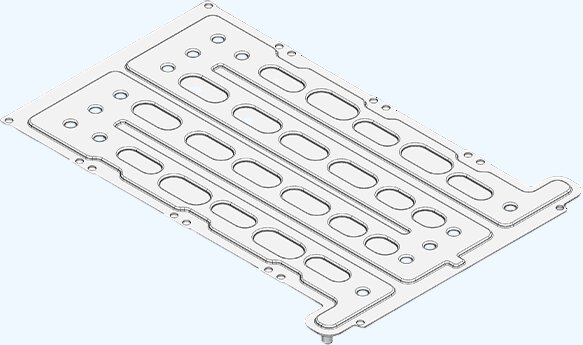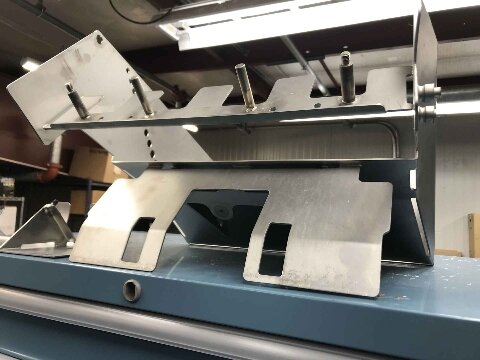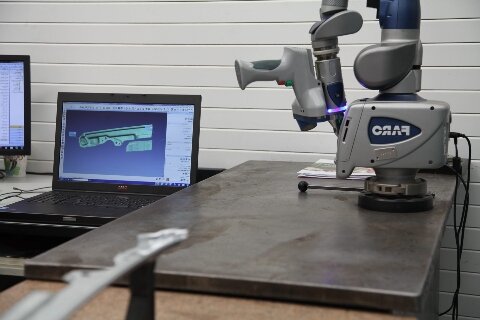يكافح العديد من المصنعين لتحقيق نتائج دقيقة وقابلة للتكرار مع الحفاظ على كفاءة التكلفة. وغالبًا ما تؤدي طرق التصنيع التقليدية إلى عدم اتساق الجودة، وأوقات إنتاج أطول، وتكاليف أعلى. يعالج التصنيع الآلي للنماذج الأولية باستخدام الحاسب الآلي هذه التحديات من خلال الجمع بين الدقة الرقمية وأوقات التسليم السريعة.
يوفر تطور تكنولوجيا التحكم الرقمي باستخدام الحاسوب إمكانيات مثيرة للشركات المستعدة لتعزيز قدراتها التصنيعية. دعونا نستكشف كيف تشكل هذه التقنية مستقبل التصنيع الدقيق.
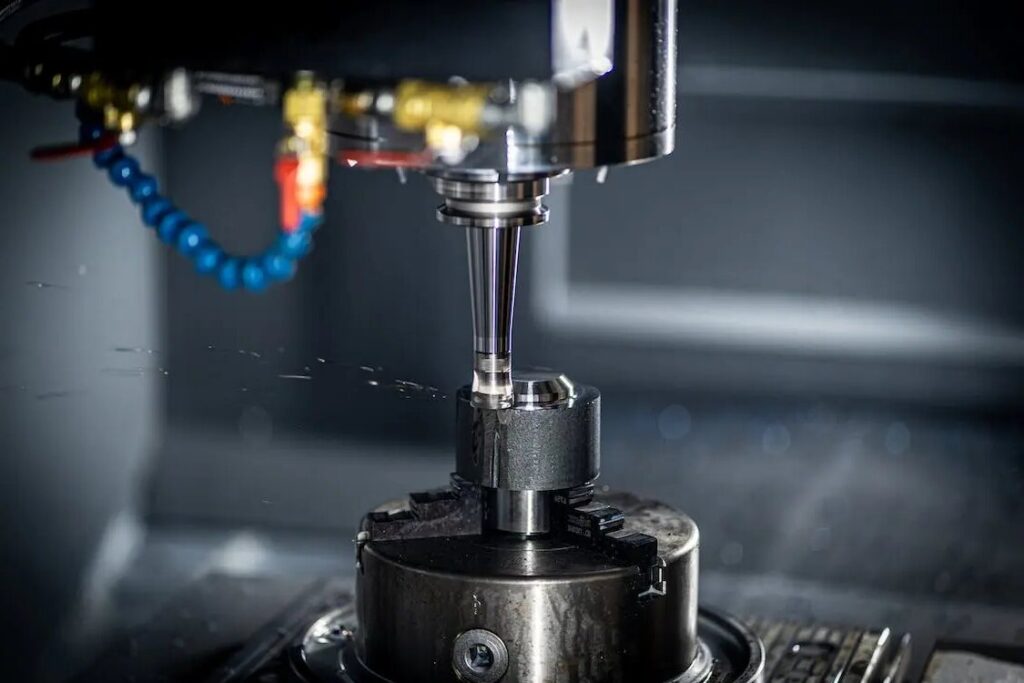
ما هو التصنيع الآلي للنماذج الأولية باستخدام الحاسوب؟
يعمل التصنيع الآلي للنماذج الأولية باستخدام الحاسب الآلي على إنشاء نماذج أولية دقيقة من النماذج الرقمية من خلال تقنية التحكم الرقمي باستخدام الحاسب الآلي. تبدأ العملية بتحويل تصميمات التصميم بمساعدة الحاسوب ثلاثية الأبعاد إلى تعليمات تصنيع آلي. ثم تقوم ماكينة بنظام التحكم الرقمي باستخدام الحاسب الآلي بإزالة المواد من كتلة صلبة لتشكيل الجزء النهائي.
تساعد طريقة النماذج الأولية السريعة هذه على تحديد عيوب التصميم في وقت مبكر. يمكن للمصنعين اختبار الوظائف ودقة التصميم قبل الانتقال إلى الإنتاج بكميات كبيرة.
أنواع ماكينات التحكم الرقمي باستخدام الحاسب الآلي المستخدمة في النماذج الأولية
تلعب ماكينات التحكم الرقمي بنظام التحكم الرقمي دورًا حاسمًا في صناعة النماذج الأولية الحديثة، حيث تقدم تقنيات مختلفة لتعزيز الدقة والكفاءة. دعونا نستكشف الأنواع المختلفة لماكينات بنظام التحكم الرقمي ومزاياها الفريدة.
التصنيع الآلي متعدد المحاور باستخدام الحاسوب
يعمل التصنيع الآلي متعدد المحاور باستخدام الحاسوب على تعزيز قدرات الماكينات بنظام التحكم الرقمي التقليدية عن طريق إضافة محاور دوران إضافية. وهذا يسمح بإنشاء الأشكال الهندسية المعقدة والميزات المعقدة التي تكافح الماكينات القياسية ثلاثية المحاور لتحقيقها.
التصنيع الآلي عالي السرعة باستخدام الحاسب الآلي (HSM)
يركز التصنيع الآلي عالي السرعة (HSM) على تحقيق معدلات إزالة عالية للمعادن مع الحفاظ على الدقة. ويستخدم سرعات أعلى للمغزل وسرعات قطع أخف، مما يقلل من أزمنة الدورات ويحسن من عمر الأداة.
التصنيع الآلي للقطع بالليزر باستخدام الحاسب الآلي
القطع بالليزر باستخدام الحاسب الآلي تستخدم شعاع ليزر عالي الطاقة لقطع المواد أو نقشها بدقة كبيرة. تسمح هذه الطريقة بعمل تصميمات معقدة غالباً ما تكون مستحيلة باستخدام تقنيات القطع التقليدية.
التصنيع الآلي بالتفريغ الكهربائي (EDM)
تستخدم ماكينات التفريغ الكهربائي (EDM) شرارات كهربائية لتآكل المواد من قطعة العمل. هذه التقنية فعالة في إنشاء أشكال معقدة في المواد الصلبة التي يصعب تصنيعها باستخدام الطرق التقليدية.
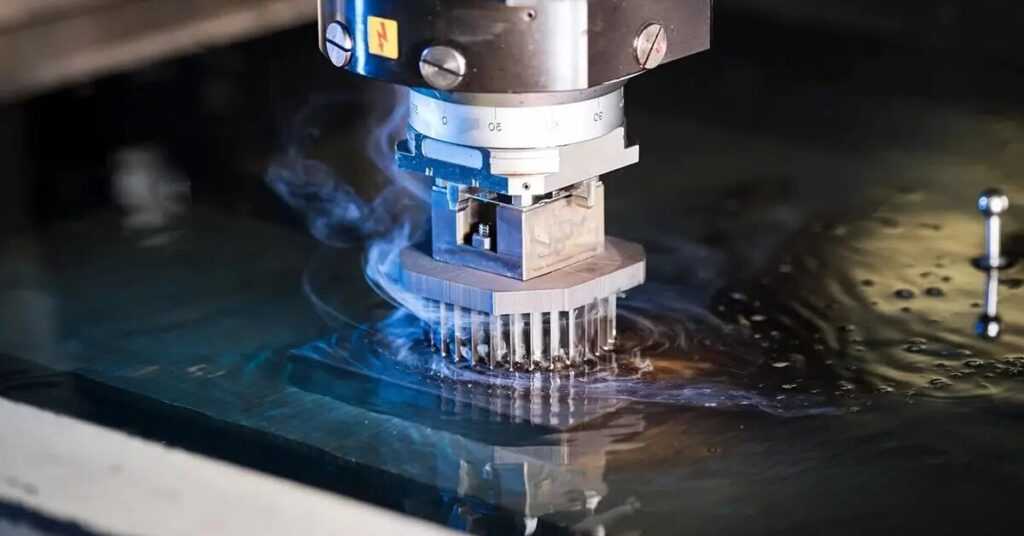
مزايا التصنيع الآلي للنماذج الأولية باستخدام الحاسب الآلي
يوفر التصنيع الآلي للنماذج الأولية باستخدام الحاسب الآلي العديد من المزايا التي تجعله خيارًا مثاليًا للنماذج الأولية السريعة في مختلف الصناعات. فيما يلي بعض المزايا الرئيسية:
- دقة ودقة عالية: تعمل الماكينات بنظام التحكم الرقمي باستخدام الحاسب الآلي بدقة يتم التحكم فيها بالكمبيوتر، مما يحقق تفاوتات ضيقة تصل إلى ± 0.01 مم.
- الفعالية من حيث التكلفة: يُلغي التصنيع الآلي باستخدام الحاسب الآلي الحاجة إلى قوالب وأدوات باهظة الثمن، مما يجعله خيارًا أكثر اقتصادًا لعمليات الإنتاج الصغيرة والنماذج الأولية.
- كفاءة الوقت: يمكن لماكينات التحكم الرقمي باستخدام الحاسب الآلي أن تعمل بشكل مستمر دون فواصل، مما يسرع بشكل كبير من عملية وضع النماذج الأولية.
- تعدد استخدامات المواد: يمكن أن تعمل الماكينات بنظام التحكم الرقمي مع مجموعة كبيرة من المواد، بما في ذلك المعادن والبلاستيك والمواد المركبة.
- الاتساق والتكرار: بمجرد برمجتها، يمكن لماكينات التحكم الرقمي بنظام التحكم الرقمي إنتاج قطع متطابقة ذات قابلية تكرار عالية.
حدود التصنيع الآلي للنماذج الأولية باستخدام الحاسب الآلي
في حين أن التصنيع الآلي للنماذج الأولية باستخدام الحاسب الآلي يوفر العديد من المزايا، إلا أن له أيضًا العديد من القيود التي يجب على المصنعين أخذها في الاعتبار:
- عملية الطرح: الماكينات بنظام التحكم الرقمي هي عملية طرح، مما يعني أنها تزيل المواد من قطعة العمل لإنشاء الجزء النهائي. يمكن أن يؤدي ذلك إلى زيادة استخدام المواد والهدر.
- القيود الهندسية: تعمل ماكينات التحكم الرقمي بنظام التحكم الرقمي بشكل أساسي من الخارج إلى الداخل، مما يجعل من الصعب إنتاج نماذج أولية ذات أشكال هندسية داخلية معقدة.
- تكاليف أعلى: يمكن أن تكون تكاليف المواد المرتبطة بالتشغيل الآلي باستخدام الحاسب الآلي أكثر أهمية من تكاليف الطباعة ثلاثية الأبعاد.
- الخبرة الفنية المطلوبة: يتطلب تشغيل ماكينات التحكم الرقمي باستخدام الحاسوب معرفة متخصصة في تصميم التصميم بمساعدة الحاسوب وبرمجة الماكينات.
المواد المستخدمة في التصنيع الآلي للنماذج الأولية باستخدام الحاسب الآلي
التصنيع الآلي للنماذج الأولية باستخدام الحاسب الآلي متعدد الاستخدامات ويمكنه استيعاب مجموعة كبيرة من المواد. إليك نظرة فاحصة على الفئات الأساسية المستخدمة في العملية:
المعادن
- الألومنيوم: يُعرف الألومنيوم بقابليته الممتازة للتشغيل الآلي، وهو خفيف الوزن ويتميز بنسبة قوة إلى وزن كبيرة.
- الفولاذ: تشتهر سبائك الفولاذ المختلفة، بما في ذلك الفولاذ الكربوني، بمتانتها وقوتها.
- التيتانيوم: يتميز هذا المعدن بقوة وخفة وزن لا تصدق، مما يجعله مثاليًا للتطبيقات عالية الأداء في صناعات الطيران والصناعات الطبية.
البلاستيك
- ABS (أكريلونيتريل بوتادين ستايرين): لدائن حرارية فعالة من حيث التكلفة معروفة بمقاومتها الجيدة للصدمات وقابليتها للتشغيل الآلي.
- PEEK (بولي إيثر كيتون الأثير متعدد الإيثر): بلاستيك هندسي ذو ثبات حراري ومقاومة كيميائية عالية ومناسب للتطبيقات الصعبة.
- النايلون: توفر هذه المادة قوة ومرونة عالية، مما يجعلها مثالية للتروس والمحامل والمكونات الميكانيكية الأخرى.
المركبات
- ألياف الكربون: تُستخدم مركبات ألياف الكربون المعروفة بنسبة قوتها إلى وزنها العالية في التطبيقات التي تتطلب مواد خفيفة الوزن لكنها قوية.
- الألياف الزجاجية: غالباً ما يتم دمجها مع الراتنجات لإنشاء مواد مركبة متينة مقاومة للصدمات والتآكل.
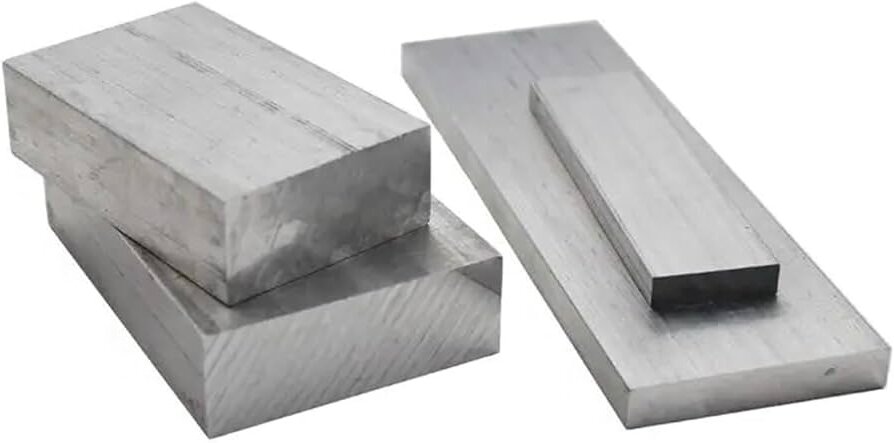
دور التصميم بمساعدة الحاسوب والتصنيع بمساعدة الحاسوب في النماذج الأولية باستخدام الحاسب الآلي
تُعد تقنيات التصميم بمساعدة الحاسوب والتصنيع بمساعدة الحاسوب (CAD) وتقنيات التصميم بمساعدة الحاسوب (CAD) من التقنيات الحيوية في تطوير النماذج الأولية باستخدام الحاسب الآلي، مما يضمن الدقة والكفاءة في جميع مراحل عمليات التصميم والتصنيع. دعونا نستكشف أدوارها وكيفية تعزيزها لتطوير النماذج الأولية.
التصميم بمساعدة الحاسوب (CAD)
الأهمية في دقة النماذج الأولية
تعد برمجيات التصميم بمساعدة الحاسوب ضرورية لتحقيق دقة عالية في النماذج الأولية. فهي تسمح للمصممين بإنشاء نماذج ثلاثية الأبعاد مفصلة تمثل المنتج النهائي بدقة، مما يضمن الحفاظ على الأبعاد والتفاوتات المسموح بها طوال عملية التصنيع.
برامج CAD الشائعة المستخدمة في النماذج الأولية باستخدام الحاسب الآلي
تُستخدم العديد من خيارات برامج CAD على نطاق واسع في النماذج الأولية باستخدام الحاسب الآلي، بما في ذلك:
- سوليدووركس: تشتهر سوليدووركس بقدراتها القوية في النمذجة ثلاثية الأبعاد وتكاملها مع برنامج CAM، وهي مشهورة بين المهندسين الذين يصممون مكونات معقدة.
- Autodesk Inventor: يوفر هذا البرنامج ميزات متقدمة لإنشاء تصميمات ميكانيكية مفصلة ويتكامل بشكل جيد مع منتجات Autodesk الأخرى.
- Fusion 360: حل شامل يجمع بين وظائف التصميم بمساعدة الحاسوب والتصنيع بمساعدة الحاسوب والتصنيع بمساعدة الحاسوب، يتيح Fusion 360 الانتقال السلس من التصميم إلى التصنيع.
التصنيع بمساعدة الحاسوب (CAM)
الدور في توليد مسارات الأدوات
يلعب برنامج CAM دورًا حاسمًا في النماذج الأولية للماكينات بنظام التحكم الرقمي من خلال توليد مسارات الأدوات بناءً على نماذج التصميم بمساعدة الحاسوب. فهي تترجم التصميمات الرقمية إلى كود G، الذي يرشد ماكينات التحكم الرقمي بنظام التحكم الرقمي إلى كيفية الحركة والتشغيل.
التكامل بين التصميم بمساعدة الحاسوب والتصنيع بمساعدة الحاسوب لسير عمل سلس
يؤدي التكامل بين التصميم بمساعدة الحاسوب والتصنيع بمساعدة الحاسوب إلى إنشاء سير عمل مبسط يعزز الكفاءة ويقلل من الأخطاء. ومن خلال السماح بالتواصل في الوقت الفعلي بين مرحلتي التصميم والتصنيع، يتيح هذا التكامل إجراء تعديلات وتحسينات سريعة.
الدقة والتفاوتات المسموح بها في النماذج الأولية باستخدام الحاسب الآلي
تُعد الدقة والتفاوتات المسموح بها أمرًا بالغ الأهمية في النماذج الأولية للتصنيع باستخدام الحاسب الآلي، مما يؤثر بشكل مباشر على وظائف القِطع وجودتها. دعونا ندرس التفاوتات المسموح بها الشائعة، والعوامل التي تؤثر على الدقة، وأهمية التفاوتات المسموح بها بدقة.
التفاوتات المسموح بها الشائعة في التصنيع باستخدام الحاسب الآلي
يمكن للتشغيل الآلي باستخدام الحاسب الآلي تحقيق تفاوتات تفاوتات تفاوت مختلفة اعتمادًا على العملية والمواد المستخدمة. تشمل التفاوتات المسموح بها الشائعة ما يلي:
- التفاوتات القياسية: عادةً حوالي ± 0.005 بوصة (± 0.13 مم) للأجزاء المعدنية و± 0.010 بوصة (± 0.25 مم) للأجزاء البلاستيكية. تُستخدم هذه القيم غالبًا عندما لا يحدد العميل تفاوتًا محددًا.
- التفاوتات الضيقة: بالنسبة للتطبيقات عالية الدقة، يمكن أن تكون التفاوتات المسموح بها ضيقة مثل ± 0.001 بوصة (± 0.025 مم).
العوامل المؤثرة على الدقة في النماذج الأولية
تؤثر عدة عوامل على دقة النماذج الأولية باستخدام الحاسب الآلي:
- حالة الماكينة: تؤثر حالة ماكينة التحكم الرقمي CNC، بما في ذلك التآكل والمعايرة، تأثيرًا مباشرًا على الدقة.
- الأدوات: تؤثر جودة أدوات القطع وحالتها على دقة التصنيع الآلي.
- خصائص المواد: تستجيب المواد المختلفة بشكل مختلف لعمليات التصنيع الآلي، مما يؤثر على مدى دقة الحفاظ على التفاوتات المسموح بها.
- معلمات القطع: تعد الإعدادات المثلى لمعدل التغذية، وسرعة عمود الدوران، وعمق القطع ضرورية لتحقيق الدقة المطلوبة.
- مهارة المشغِّل: تلعب خبرة الميكانيكي في الإعداد والتشغيل واستكشاف الأعطال وإصلاحها دورًا مهمًا في الحفاظ على الدقة العالية.
تطبيقات التصنيع الآلي للنماذج الأولية باستخدام الحاسب الآلي
يتم استخدام التصنيع الآلي للنماذج الأولية باستخدام الحاسب الآلي على نطاق واسع في مختلف الصناعات، مما يوفر حلولاً دقيقة وفعالة لتطوير المنتجات. فيما يلي بعض التطبيقات الرئيسية:
صناعة السيارات
يتطلب قطاع السيارات مكونات دقيقة:
- كتل ورؤوس المحرك (تفاوت ± 0.001″)
- تروس ناقل الحركة والأعمدة
- ملاقط الفرامل والدوارات
- أجزاء التعليق المخصصة
- أدوات الاختبار والتحقق من الصحة
الفضاء الجوي والدفاع
تركز متطلبات الفضاء الجوي على المكونات الحرجة:
- النماذج الأولية لشفرة التوربينات
- مكونات نظام الوقود
- أجزاء معدات الهبوط
- عناصر سطح التحكم
- الأقواس الهيكلية
مستهلكى الكترونيات
احتياجات تصنيع الإلكترونيات:
- مرفقات الجهاز
- الهيكل الداخلي
- أجزاء الإدارة الحرارية
- تصاعد بين قوسين
- تركيبات الاختبار
الطب والرعاية الصحية
تشمل التطبيقات الطبية ما يلي:
- الأدوات الجراحية الدقيقة
- النماذج الأولية للزراعة
- علب الأجهزة الطبية
- معدات التشخيص
- أدوات مخصصة
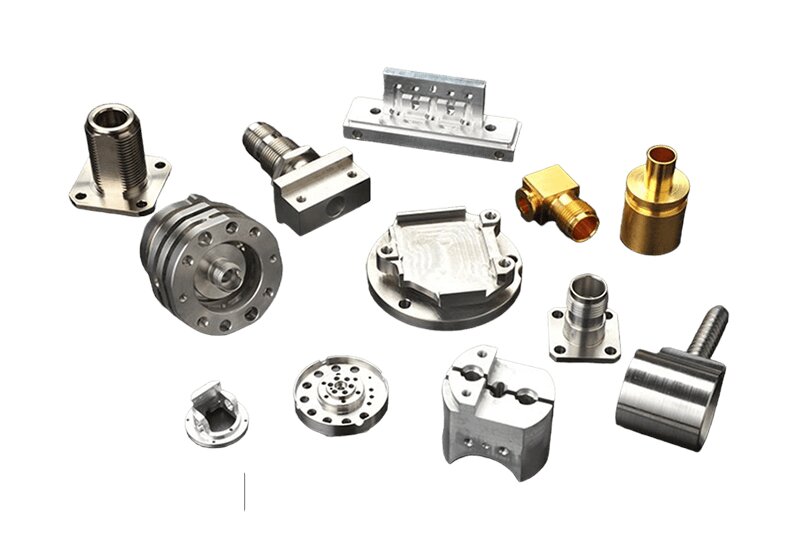
خاتمة
يُعد التصنيع الآلي للنماذج الأولية باستخدام الحاسب الآلي أداة قوية تعزز تطوير المنتجات في مختلف الصناعات. من خلال فهم مبادئ التصميم والدقة وتطبيقات تقنية التحكم الرقمي باستخدام الحاسوب، يمكن للمصنعين إنشاء نماذج أولية عالية الجودة تلبي المتطلبات الصارمة.
إذا كنت مستعداً للارتقاء بمشروعك إلى المستوى التالي, اتصل بنا اليوم للحصول على إرشادات الخبراء بشأن حلول النماذج الأولية للتصنيع باستخدام الحاسب الآلي المصممة خصيصًا لتلبية احتياجاتك. فريقنا هنا لمساعدتك في تحويل أفكارك إلى واقع ملموس بدقة وكفاءة. لا تتردد - دعنا نبدأ مشروعك معًا!
مهلا، أنا كيفن لي

على مدى السنوات العشر الماضية، كنت منغمسًا في أشكال مختلفة من تصنيع الصفائح المعدنية، وشاركت رؤى رائعة هنا من تجاربي عبر ورش العمل المتنوعة.
ابقى على تواصل

كيفن لي
لدي أكثر من عشر سنوات من الخبرة المهنية في تصنيع الصفائح المعدنية، وتخصصت في القطع بالليزر، والثني، واللحام، وتقنيات معالجة الأسطح. كمدير فني في شنغن، أنا ملتزم بحل تحديات التصنيع المعقدة ودفع الابتكار والجودة في كل مشروع.

